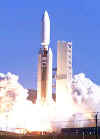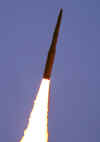|
Vandenberg AFB, California |
|
| Vandenberg
AFB was my first assignment with the Air Force. I arrived there on
January 21, 1977 till June 1979. I was assigned to the 4392nd
Transportation Squadron. Initially I was a "taxi driver" and
also supported Minuteman and Titan launches. My support of those
launches were basically sitting around in a wrecker (tow truck) until
the launch happened. Most fun I had was when the SAC Missile Combat
Competition (Olympic
Arena) happened.
If anyone has an image of the 4392nd Transportation Squadron logo I would greatly appreciate it. |
|
|
Vandenberg AFB History |
|
|
Vandenberg Air Force Base is
located on the Central Coast of California about 150 miles northwest of The German Blitzkrieg of
World War II illustrated clearly that a new and more deadly dimension
had been added to modern warfare. In response to this new threat, the
U.S. Army sought improved training centers for the rapid development of
its armored and infantry forces. Having conducted a survey of the
Lompoc-Guadalupe-Santa Maria triangle, the Army purchased approximately
86,000 acres of land in March 1941. With its flat plateau, surrounding
hills, numerous nearby canyons, and relative remoteness from populated
areas, the Army was convinced that it had found the ideal training
location. Construction of the Army camp
began in September 1941. Although camp construction continued well into
1942, troop training did not wait. The 5th Armored Division rolled into
camp in February and March, and the steady roar of its tanks and
artillery soon became part of the daily scene. From then until the end
of the war, other armored and infantry divisions kept up the din before
they left to put their well learned lessons to practice in combat. Besides the 5th Division, the
6th, 11th, 13th, and 20th Armored Divisions, which were stationed at
Cooke for varying periods during the war, the famed 2nd Filipino
Infantry Regiment also trained here as did an assortment of
anti-aircraft artillery, combat engineer, and ordnance units. Over 400
separate and distinct outfits passed through A maximum security army
disciplinary barracks (now the United States Penitentiary at With the advent of the
missile age in the 1950s, the Air Force recommended transfer of In November 1956, Secretary
of Defense, Charles E. Wilson, directed the transfer of 64,000 acres of
North Camp Cooke to the Air Force; two months later the first Air Force
unit, the 6591st Support Squadron, was established at Cooke. By the time the Air Force
began ground breaking for the future missile base in May 1957, it had
already activated at Cooke the 392d Air Base Group and simultaneously
inactivated the 6591st Support Squadron on The buildup of men and
equipment during this time was matched by a significant increase in the
number of buildings going up on base. Missile facilities and launch
complexes also appeared as tons of concrete and steel gradually
transformed the landscape. Meanwhile, in October 1957 Along with the transfer, SAC
acquired the three ARDC base organizations and responsibility for
attaining initial operational capability (IOC) for the burgeoning Site activation, and research
and development testing of ballistic missiles remained with ARDC. Space
launches were to be conducted jointly by both commands. Although the
mission at Cooke was now divided between ARDC and SAC, the two commands
cultivated a close relationship that was to flourish for the next 35
years. On Renamed Air Force Systems
Command (AFSC) on The first missile launch from
Vandenberg AFB was a Thor IRBM on In 1961, the Titan I entered
the inventory at Vandenberg AFB, but a more advanced version with
storable propellants, all inertial guidance, and in-silo launch
capability--the Titan II--was already in the process of development.
More importantly, the solid-propellant, three-stage Minuteman ICBM was
under development and began flight tests at Vandenberg in September
1962. In subsequent years, other
launch vehicles followed including the Peacekeeper (MX) ICBM beginning
in June 1983, the Titan IV space booster in March 1991, the air-launched
Pegasus booster in April 1995, and most recently the Delta II commercial
space booster in February 1996. By April 1996, 1,721 orbital and
ballistic missiles had lifted off from Vandenberg AFB. In addition, Vandenberg AFB
was the sight of the Air Force's Manned Orbiting Laboratory (MOL) and
the Space Shuttle programs. Construction work for MOL began at Space
Launch Complex 6 (SLC-6) in March 1966. Three years later, in June 1969,
the project was canceled, the victim of cost overruns, completion
delays, and emerging new technologies. After nearly a decade of
abandonment, SLC-6 was reactivated and underwent an estimated $4 billion
modification program in preparation for the Space Shuttle, beginning in
January 1979. Persistent site technical problems, however, and a joint
decision by the Air Force and NASA to consolidate Shuttle operations at Vandenberg Air Force Base is the site of the 40th Infantry Division Korean War Memorial. |
|
|
Vandenberg AFB Pictures |
|
 |
 |
| Strategic Air Command Logo | Space
Launch Complex 6 (SLC6)
I watched many missile launches from this facility. Even though it was miles away from the apartment I lived (in Lompoc) it would still shake the walls when a missile launce occurred. |
 |
 |
| Titan IV Launch | Minuteman III Missile Launce MPEG |